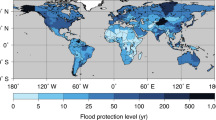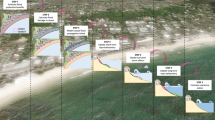Abstract
Increasing flood risk, salinization and waterlogging threaten the lives and livelihoods of more than 35 million people in Bangladesh’s coastal zone. While planning models have long been used to inform investments in water infrastructure, they frequently overlook interacting risks, impacts on the poor and local context. We address this gap by developing and applying a stochastic-optimization model to simulate the impact of flood embankment investments on the distribution of agricultural incomes across income groups for six diverse polders (embanked areas) in coastal Bangladesh. Results show that increasing salinity and waterlogging negate the benefits of embankment rehabilitation in improving agricultural production while improved drainage can alleviate these impacts. Outcomes vary across income groups, with risks of crop loss being greatest for the poor. We discuss the need for planning models to consider the interacting benefits and risks of infrastructure investments within a local political economy to better inform coastal adaptation decisions.
This is a preview of subscription content, access via your institution
Access options
Access Nature and 54 other Nature Portfolio journals
Get Nature+, our best-value online-access subscription
$29.99 / 30 days
cancel any time
Subscribe to this journal
Receive 12 digital issues and online access to articles
$119.00 per year
only $9.92 per issue
Buy this article
- Purchase on Springer Link
- Instant access to full article PDF
Prices may be subject to local taxes which are calculated during checkout





Similar content being viewed by others
Data availability
The data generated for this study are available within the paper and Supplementary Information. Data analysed from third-party sources are available, but restrictions may apply to the availability of some of these data, which were accessed under specific agreements associated with the current study.
Code availability
Code used to undertake our analysis can be found at https://github.com/EmilyWaterModelling/CoastalRisk.
References
Mora, C. et al. Broad threat to humanity from cumulative climate hazards intensified by greenhouse gas emissions. Nat. Clim. Change 8, 1062–1071 (2018).
AghaKouchak, A. et al. How do natural hazards cascade to cause disasters? Nature 561, 458–460 (2018).
Brammer, H. Agriculture and food production in polder areas. Water Int. 8, 74–81 (1983).
Flood Action Plan 4 (FAP 4). Southwest Area Water Resources Management Project, Final Report (People’s Republic of Bangladesh, Ministry of Irrigation, Water Development and Flood Control, 1993).
Afroz, S., Cramb, R. & Grünbühel, C. Exclusion and counter-exclusion: the struggle over shrimp farming in a coastal village in Bangladesh. Dev. Change 48, 692–720 (2017).
Adnan, S. in Water, Sovereignty and Borders: Fresh and Salt in Asia and Oceania (eds Ghosh, D. et al.) 104–124 (Routledge, 2009).
Paprocki, K. & Cons, J. Life in a shrimp zone: aqua- and other cultures of Bangladesh’s coastal landscape. J. Peasant Stud. 41, 1109–1130 (2014).
Nowreen, S., Jalal, M. R. & Shah Alam Khan, M. Historical analysis of rationalizing south west coastal polders of Bangladesh. Water Policy 16, 264–279 (2013).
Swapan, M. S. H. & Gavin, M. A desert in the delta: participatory assessment of changing livelihoods induced by commercial shrimp farming in Southwest Bangladesh. Ocean Coast. Manage. 54, 45–54 (2011).
Grey, D. & Sadoff, C. W. Sink or swim? Water security for growth and development. Water Policy 9, 545–571 (2007).
Dadson, S. et al. Water security, risk, and economic growth: insights from a dynamical systems model. Water Resour. Res. 53, 6425–6438 (2017).
Hall, J. W. et al. Coping with the curse of freshwater variability. Science 346, 429–430 (2014).
Di Baldassarre, G. et al. Water shortages worsened by reservoir effects. Nat. Sustain. 1, 617–622 (2018).
Palmer, M. A., Liu, J., Matthews, J. H., Mumba, M. & D’Odorico, P. Manage water in a green way. Science 349, 584–585 (2015).
Tortajada, C. Water infrastructure as an essential element for human development. Int. J. Water Resour. Dev. 30, 8–19 (2014).
Zeitoun, M. et al. Reductionist and integrative research approaches to complex water security policy challenges. Glob. Environ. Change 39, 143–154 (2016).
Howe, C. et al. Paradoxical infrastructures: ruins, retrofit, and risk. Sci. Technol. Human Values 41, 547–565 (2016).
Gleick, P. H. Global freshwater resources: soft-path solutions for the 21st century. Science 302, 1524–1528 (2003).
Eriksen, S. et al. Adaptation interventions and their effect on vulnerability in developing countries: help, hindrance or irrelevance? World Dev. 141, 105383 (2021).
Anand, N., Gupta, A. & Appel, H. The Promise of Infrastructure (Duke Univ. Press, 2018).
Thacker, S. et al. Infrastructure for sustainable development. Nat. Sustain. 2, 324–331 (2019).
Poff, N. L. et al. Sustainable water management under future uncertainty with eco-engineering decision scaling. Nat. Clim. Change 6, 25–34 (2016).
Winemiller, K. O. et al. Balancing hydropower and biodiversity in the Amazon, Congo, and Mekong. Science 351, 128–129 (2016).
Loftus, A. Water (in)security: securing the right to water. Geographical J. 181, 350–356 (2015).
Haasnoot, M. et al. Investments under non-stationarity: economic evaluation of adaptation pathways. Climatic Change https://doi.org/10.1007/s10584-019-02409-6 (2019).
Hino, M. & Hall, J. W. Real options analysis of adaptation to changing flood risk: structural and nonstructural measures. ASCE ASME J. Risk Uncertain. Eng. Syst. A 3, 04017005 (2017).
Borgomeo, E., Hall, J. W. & Salehin, M. Avoiding the water-poverty trap: insights from a conceptual human–water dynamical model for coastal Bangladesh. Int. J. Water Resour. Dev. 34, 900–922 (2018).
Verschuur, J., Koks, E. E., Haque, A. & Hall, J. W. Prioritising resilience policies to reduce welfare losses from natural disasters: a case study for coastal Bangladesh. Glob. Environ. Change 65, 102179 (2020).
Lázár, A. N. et al. Agricultural livelihoods in coastal Bangladesh under climate and environmental change—a model framework. Environ. Sci. Process. Impacts 17, 1018–1031 (2015).
Paprocki, K. Threatening dystopias: development and adaptation regimes in Bangladesh. Ann. Am. Assoc. Geogr. 108, 955–973 (2018).
Yearbook of Agricultural Statistics-2016 (Bangladesh Bureau of Statistics, Statistics and Information Division, Ministry of Planning, Government of the People’s Republic of Bangladesh, 2017).
Haque, A., Kay, S. & Nicholls, R. J. in Ecosystem Services for Well-Being in Deltas: Integrated Assessment for Policy Analysis (eds Nicholls, R. J. et al.) 293–314 (Springer, 2018).
Adnan, M. S. G., Haque, A. & Hall, J. W. Have coastal embankments reduced flooding in Bangladesh? Sci. Total Environ. 682, 405–416 (2019).
National Water Resources Database (NWRD) (Bangladesh Water Resources Planning Organization, 2018).
Census of Agriculture 2008 (Bangladesh Bureau of Statistics, Planning Division, Ministry of Planning, Government of the People’s Republic of Bangladesh, 2011).
Dasgupta, S., Hossain, M. M., Huq, M. & Wheeler, D. Climate change and soil salinity: the case of coastal Bangladesh. Ambio 44, 815–826 (2015).
Salehin, M. et al. in Ecosystem Services for Well-Being in Deltas: Integrated Assessment for Policy Analysis (eds Nicholls, R. J. et al.) 333–347 (Springer, 2018).
Rabbani, G., Rahman, A. & Mainuddin, K. Salinity-induced loss and damage to farming households in coastal Bangladesh. Int. J. Glob. Warm. 5, 400–415 (2013).
Saline Soils of Bangladesh (Soil Resource Development Institute, SRMAF Project, Ministry of Agriculture, 2010).
Alam, M. S., Sasaki, N. & Datta, A. Waterlogging, crop damage and adaptation interventions in the coastal region of Bangladesh: a perception analysis of local people. Environ. Dev. 23, 22–32 (2017).
Farr, T. G. et al. The shuttle radar topography mission. Rev. Geophys. https://doi.org/10.1029/2005rg000183 (2007).
Poverty in Bangladesh: Building on Progress (World Bank and Asian Development Bank, 2002).
Hall, J. W., Brown, S., Nicholls, R. J., Pidgeon, N. F. & Watson, R. T. Proportionate adaptation. Nat. Clim. Change 2, 833–834 (2012).
Development Project Proforma/Proposal (DPP) for Blue Gold Program (BWDB Component) (Government of the People’s Republic of Bangladesh, Ministry of Water Resources, Bangladesh Water Development Board, 2013).
del Ninno, C., Dorosh, P., Smith, L. & Roy, D. The 1998 Floods in Bangladesh Disaster Impacts, Household Coping Strategies, and Response Research Report (International Food Policy Research Institute, 2001).
van Staveren, M. F., Warner, J. F. & Shah Alam Khan, M. Bringing in the tides. From closing down to opening up delta polders via tidal river management in the southwest delta of Bangladesh. Water Policy 19, 147–164 (2016).
Adnan, M. S. G., Talchabhadel, R., Nakagawa, H. & Hall, J. W. The potential of tidal river management for flood alleviation in south western Bangladesh. Sci. Total Environ. 731, 138747 (2020).
Auerbach, L. W. et al. Flood risk of natural and embanked landscapes on the Ganges–Brahmaputra tidal delta plain. Nat. Clim. Change 5, 153–157 (2015).
Bangladesh Delta Plan 2100 Draft Report (Government of the People’s Republic of Bangladesh, 2017).
Brouwer, R., Akter, S., Brander, L. & Haque, E. Socioeconomic vulnerability and adaptation to environmental risk: a case study of climate change and flooding in Bangladesh. Risk Anal. 27, 313–326 (2007).
Bangladesh Vision 2021 (Centre for Policy Dialogue, 2007).
Project Information Document (PID) Appraisal Stage: Coastal Embankment Improvement Project—Phase 1 (CEIP-1) (World Bank, 2013).
Hallegatte, S., Vogt-Schilb, A., Bangalore, M. & Rozenberg, J. Unbreakable: Building the Resilience of the Poor in the Face of Natural Disasters (World Bank, 2017).
Di Baldassarre, G. et al. Sociohydrology: scientific challenges in addressing the sustainable development goals. Water Resour. Res. 55, 6327–6355 (2019).
Nicholls, R. J. et al. Integrated assessment of social and environmental sustainability dynamics in the Ganges–Brahmaputra–Meghna delta, Bangladesh. Estuar. Coast. Shelf Sci. 183, 370–381 (2016).
Payo, A. et al. Modeling daily soil salinity dynamics in response to agricultural and environmental changes in coastal Bangladesh. Earths Future 5, 495–514 (2017).
Brown, S. & Nicholls, R. J. Subsidence and human influences in mega deltas: the case of the Ganges–Brahmaputra–Meghna. Sci. Total Environ. 527–528, 362–374 (2015).
Bangladesh Poverty Maps (Zila Upazila) (World Bank, Bangladesh Bureau of Statistics and World Food Programme, 2010).
Acknowledgements
We thank the REACH coastal risk team for their support and contributions through discussions, accessing data and facilitating field visits. We thank A. Allen for preparing Figs. 2 and 4 and M. Rahman for providing helpful references and comments. We also thank G. Kuczera for supporting the implementation of the eMoga optimization algorithm. We thank M. Mainuddin for comments that greatly improved the manuscript. This research was jointly funded by the REACH programme, which is itself funded by UK Aid from the UK Foreign, Commonwealth and Development Office (FCDO) for the benefit of developing countries (programme code 201880) (supported authors E.J.B., M.S.G.A., M.S.A.K., M.S. and J.W.H.) and CSIRO through its Water Security Research Program (E.J.B.). The views expressed and information contained in this article are not necessarily those of or endorsed by FCDO, which can accept no responsibility for such views or information or for any reliance placed on them.
Author information
Authors and Affiliations
Contributions
E.J.B. and J.W.H. designed the study. E.J.B. and J.W.H. conducted most of the analysis, with input from M.S.G.A. E.J.B. wrote most of the manuscript, with input from all authors, who helped shape the overall narrative, contributed text, provided references and produced or contributed to figures.
Corresponding author
Ethics declarations
Competing interests
The authors declare no competing interests.
Peer review
Peer review information
Nature Sustainability thanks Joyce Chen and the other, anonymous, reviewer(s) for their contribution to the peer review of this work.
Additional information
Publisher’s note Springer Nature remains neutral with regard to jurisdictional claims in published maps and institutional affiliations.
Supplementary information
Supplementary Information
Supplementary Information, Figs. 1–11 and Tables 1–8.
Rights and permissions
About this article
Cite this article
Barbour, E.J., Adnan, M.S.G., Borgomeo, E. et al. The unequal distribution of water risks and adaptation benefits in coastal Bangladesh. Nat Sustain 5, 294–302 (2022). https://doi.org/10.1038/s41893-021-00846-9
Received:
Accepted:
Published:
Issue Date:
DOI: https://doi.org/10.1038/s41893-021-00846-9
This article is cited by
-
Developing countries can adapt to climate change effectively using nature-based solutions
Communications Earth & Environment (2024)
-
Climate threats to coastal infrastructure and sustainable development outcomes
Nature Climate Change (2024)
-
Sediment delivery to sustain the Ganges-Brahmaputra delta under climate change and anthropogenic impacts
Nature Communications (2023)
-
Quantitative Evaluation of Flood Control Measures and Educational Support to Reduce Disaster Vulnerability of the Poor Based on Household-level Savings Estimates
Economics of Disasters and Climate Change (2022)



